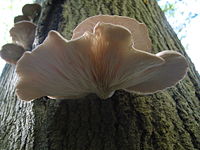
Synthetic dyes degradation using lignolytic enzymes produced from Halopiger aswanensis strain ABC_IITR by Solid State Fermentation.
Sign Up to like & getrecommendations! Published in 2021 at "Chemosphere"
DOI: 10.1016/j.chemosphere.2021.129671
Abstract: The present work focuses on studying the degradation of industrial synthetic dyes, which poses serious health hazards and a drastic impact on the environment. Currently available enzymatic processes have higher production and operational costs. However,… read more here.
Keywords: solid state; degradation; synthetic dyes; state fermentation ... See more keywords

Lignolytic mushroom Lenzites elegans WDP2: Laccase production, characterization, and bioremediation of synthetic dyes.
Sign Up to like & getrecommendations! Published in 2018 at "Ecotoxicology and environmental safety"
DOI: 10.1016/j.ecoenv.2018.04.003
Abstract: A mycoremedial study was undertaken for decolourization of synthetic dyes using wood rot fungal culture Lenzites elegans WDP2. The culture was isolated from decaying wood as fruiting body, and identified on the basis of 5.8S… read more here.
Keywords: production; synthetic dyes; laccase; lenzites elegans ... See more keywords

Chemically induced oxidative stress improved bacterial laccase-mediated degradation and detoxification of the synthetic dyes.
Sign Up to like & getrecommendations! Published in 2021 at "Ecotoxicology and environmental safety"
DOI: 10.1016/j.ecoenv.2021.112823
Abstract: To alleviate the risk of textile effluent, the development of highly effective bioremediation strategies for synthetic dye removal is needed. Herein, we aimed to assess whether intensified bioactivity of Bacillus pumilus ZB1 by oxidative stress… read more here.
Keywords: synthetic dyes; induced oxidative; laccase; congo red ... See more keywords

Combination of thermal and biological treatments for bio-removal and detoxification of some recalcitrant synthetic dyes by betaine-induced thermostabilized laccase
Sign Up to like & getrecommendations! Published in 2020 at "Environmental Technology and Innovation"
DOI: 10.1016/j.eti.2020.101046
Abstract: Abstract The presence of recalcitrant synthetic dyes in environment is a major concern due to their possible threat on living organisms and aquatic ecosystems. To investigate the potential of combined thermal and enzymatic decolorization, betaine… read more here.
Keywords: recalcitrant synthetic; presence; synthetic dyes; laccase ... See more keywords

Identification of synthetic dyes magenta III (new fuchsin) and rhodamine B as common adulterants in commercial saffron.
Sign Up to like & getrecommendations! Published in 2019 at "Food chemistry"
DOI: 10.1016/j.foodchem.2019.125793
Abstract: Saffron is a highly adulterated spice due to its limited production and high costs. Non-saffron plant material is coloured with synthetic dyes to produce counterfeit saffron. Continuous monitoring of the synthetic dyes used in counterfeit… read more here.
Keywords: magenta iii; synthetic dyes; iii new; saffron ... See more keywords

Rapid determination of seven synthetic dyes in casual snacks based on packed-fibers solid-phase extraction coupled with HPLC-DAD.
Sign Up to like & getrecommendations! Published in 2021 at "Food chemistry"
DOI: 10.1016/j.foodchem.2021.129026
Abstract: Based on packed-fiber solid-phase extraction and HPLC-DAD, a simple analytical method for the determination of seven synthetic dyes has been successfully developed. Polystyrene/polypyrrole (PS/PPy) fibers were obtained via electro-spinning of polystyrene skeletal nanofibers, followed by… read more here.
Keywords: extraction; synthetic dyes; solid phase; based packed ... See more keywords

Green bioprocess for degradation of synthetic dyes mixture using consortium of laccase-producing bacteria from Himalayan niches.
Sign Up to like & getrecommendations! Published in 2022 at "Journal of environmental management"
DOI: 10.1016/j.jenvman.2022.114764
Abstract: Microbial remediation of synthetic dyes from industrial effluents offers a sustainable and eco-friendly alternative. Herein, laccase-producing bacteria were isolated from decaying wood niches in the Himalayan region. A bacterial consortium (BC-I) was developed to decolorize… read more here.
Keywords: producing bacteria; synthetic dyes; laccase producing; degradation ... See more keywords

Synthesis of cross-linked protein-metal hybrid nanoflowers and its application in repeated batch decolorization of synthetic dyes.
Sign Up to like & getrecommendations! Published in 2018 at "Journal of hazardous materials"
DOI: 10.1016/j.jhazmat.2018.01.003
Abstract: Herein, we report the preparation of a cross-linked protein-metal hybrid nanoflower (NF) system for laccase immobilization. The immobilized laccase showed effective encapsulation yield and activity recovery of 78.1% and 204%, respectively. The catalytic efficiency (kcatVmax-1)… read more here.
Keywords: linked protein; synthetic dyes; cross linked; cross ... See more keywords

Phycoremediation of Synthetic Dyes: An Effective and Eco-Friendly Algal Technology for the Dye Abatement
Sign Up to like & getrecommendations! Published in 2021 at "Journal of Chemistry"
DOI: 10.1155/2021/9923643
Abstract: Rapid industrialization leads to serious environmental hazards due to the increase in the release of pollutants into the environment. Industries that use synthetic dyes for different applications are a predominant source for dye contaminants by… read more here.
Keywords: dye abatement; synthetic dyes; phycoremediation synthetic; eco friendly ... See more keywords

Bio-Decolorization of Synthetic Dyes by a Halophilic Bacterium Salinivibrio sp.
Sign Up to like & getrecommendations! Published in 2020 at "Frontiers in Microbiology"
DOI: 10.3389/fmicb.2020.594011
Abstract: Synthetic dyes, extensively used in various industries, act as pollutants in the aquatic environment, and pose a significant threat to living beings. In the present study, we assessed the potential of a halophilic bacterium Salinivibrio… read more here.
Keywords: synthetic dyes; bacterium salinivibrio; halophilic bacterium; decolorization ... See more keywords

Simple HPLC-PDA Analysis to Determine Illegal Synthetic Dyes in Herbal Medicines
Sign Up to like & getrecommendations! Published in 2021 at "Applied Sciences"
DOI: 10.3390/app11146641
Abstract: Various synthetic dyes are artificially added to herbal medicines for the purpose of visual attraction. In order to monitor the illegal usage of synthetic dyes in herbal medication, a rapid and straightforward analysis method to… read more here.
Keywords: synthetic dyes; analysis; herbal medicines; analysis determine ... See more keywords